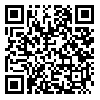Volume 19, Issue 133 (2023)
FSCT 2023, 19(133): 103-113 |
Back to browse issues page
Download citation:
BibTeX | RIS | EndNote | Medlars | ProCite | Reference Manager | RefWorks
Send citation to:



BibTeX | RIS | EndNote | Medlars | ProCite | Reference Manager | RefWorks
Send citation to:
Ghasemi A H, nazarnezhad N, Rezanezhad S, Sharifi S H. Investigating the Possibility of Producing Antibacterial Paper for Food Packaging with Rosemary (Rosmarinus Officinalis L.) Extract. FSCT 2023; 19 (133) :103-113
URL: http://fsct.modares.ac.ir/article-7-65602-en.html
URL: http://fsct.modares.ac.ir/article-7-65602-en.html
1- Doctoral student of Sari University of Agricultural Sciences and Natural Resources
2- Member of the faculty of Sari University of Agricultural Sciences and Natural Resources ,nazarnezhad91@gmail.com
3- Graduated from Sari University of Agricultural Sciences and Natural Resources
4- Member of the faculty of Sari University of Agricultural Sciences and Natural Resources
2- Member of the faculty of Sari University of Agricultural Sciences and Natural Resources ,
3- Graduated from Sari University of Agricultural Sciences and Natural Resources
4- Member of the faculty of Sari University of Agricultural Sciences and Natural Resources
Abstract: (1603 Views)
Change in the food consumption’s pattern and the widespread use of the fast foods, as well as, the globalization of the food trade and the transportation of food over the long distances have brought great challenges to the safety and quality of the foods. One of the most important uses of the papers is the food packaging industry to keep the health and quality of the packaged materials from the production step to the customer. The extract of medicinal plants has the ability to create antibacterial properties. In this research, rosemary extract was used to produce the antibacterial papers. Extraction of plant was done by using soxhlet extractor and ultrasonic. In the soxhlet method, the dry powder was extracted at 4 and 6 hours and in the ultrasonic method, 40 and 60 powers were used for extraction. Then the papers were treated with plant extract prepared in two amounts of 15 and 20% based on the dry weight of the paper. The antibacterial properties of the papers were investigated with Escherichia coli and Staphylococcus aureus bacteria. All the papers treated with rosemary extracted by soxhlet method showed antibacterial property. Inhibition zone of bacteria was formed for both of them. The maximum diameter of the Inhibition zone for Escherichia coli and Staphylococcus aureus bacteria with 6 hours’ extraction and the consumption amount of 20% was 22 and 20 mm. In the treated paper with rosemary extracted by ultrasonic method, the maximum diameter of the Inhibition zone for Escherichia coli bacteria was 20 mm in 40A and 9 min. Also, the highest diameter of the Inhibition zone for Staphylococcus aureus bacteria was 20 mm in 40A and 9 min. Gas chromatography confirmed the presence of antibacterial substances including, Borneol, Camphor, and Bornyl acetate in rosemary extract
Article Type: Original Research |
Subject:
Packing and all types of coatings in the food industry
Received: 2022/11/23 | Accepted: 2023/01/19 | Published: 2023/03/1
Received: 2022/11/23 | Accepted: 2023/01/19 | Published: 2023/03/1
Send email to the article author
| Rights and permissions | |
 |
This work is licensed under a Creative Commons Attribution-NonCommercial 4.0 International License. |










